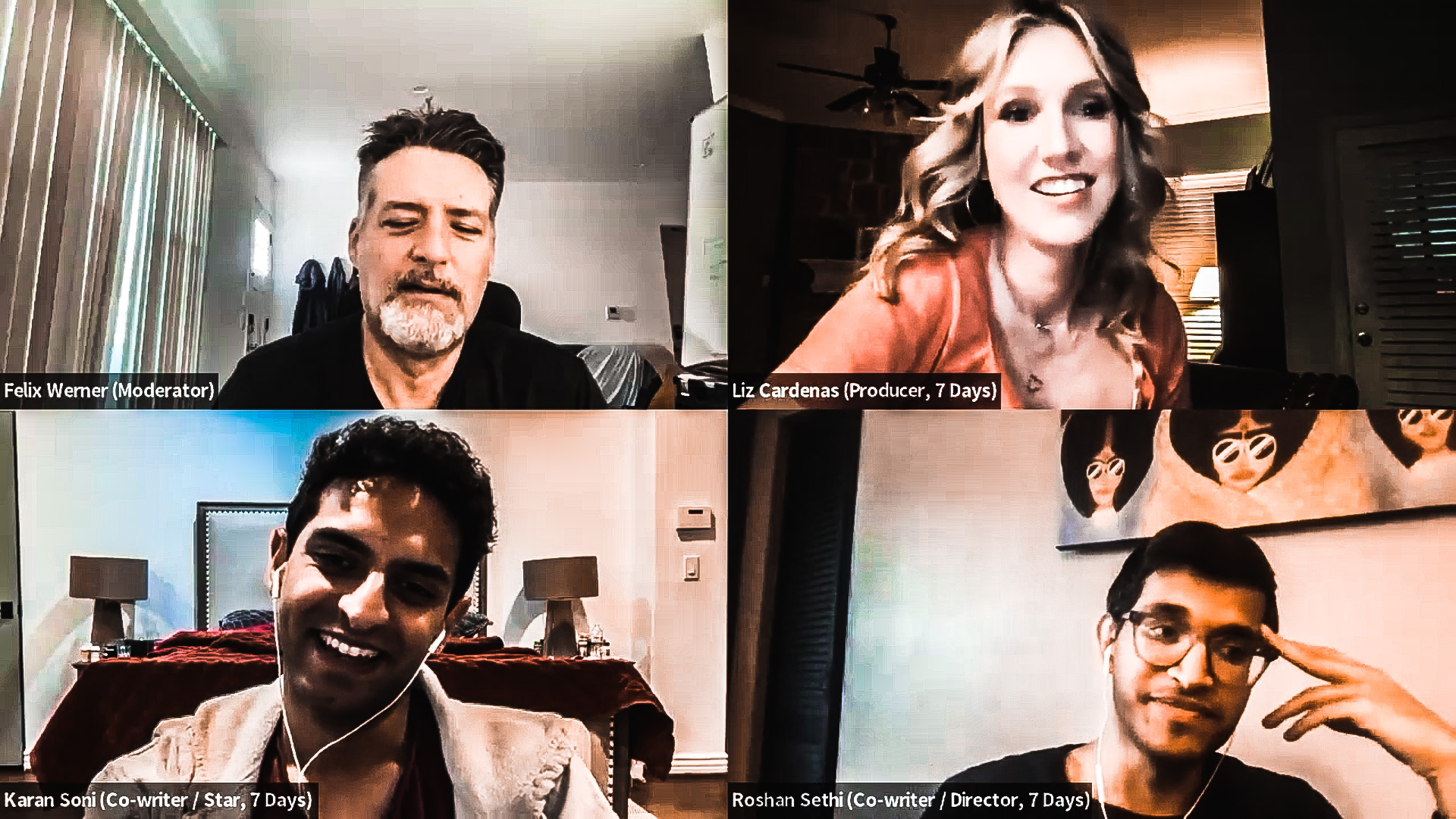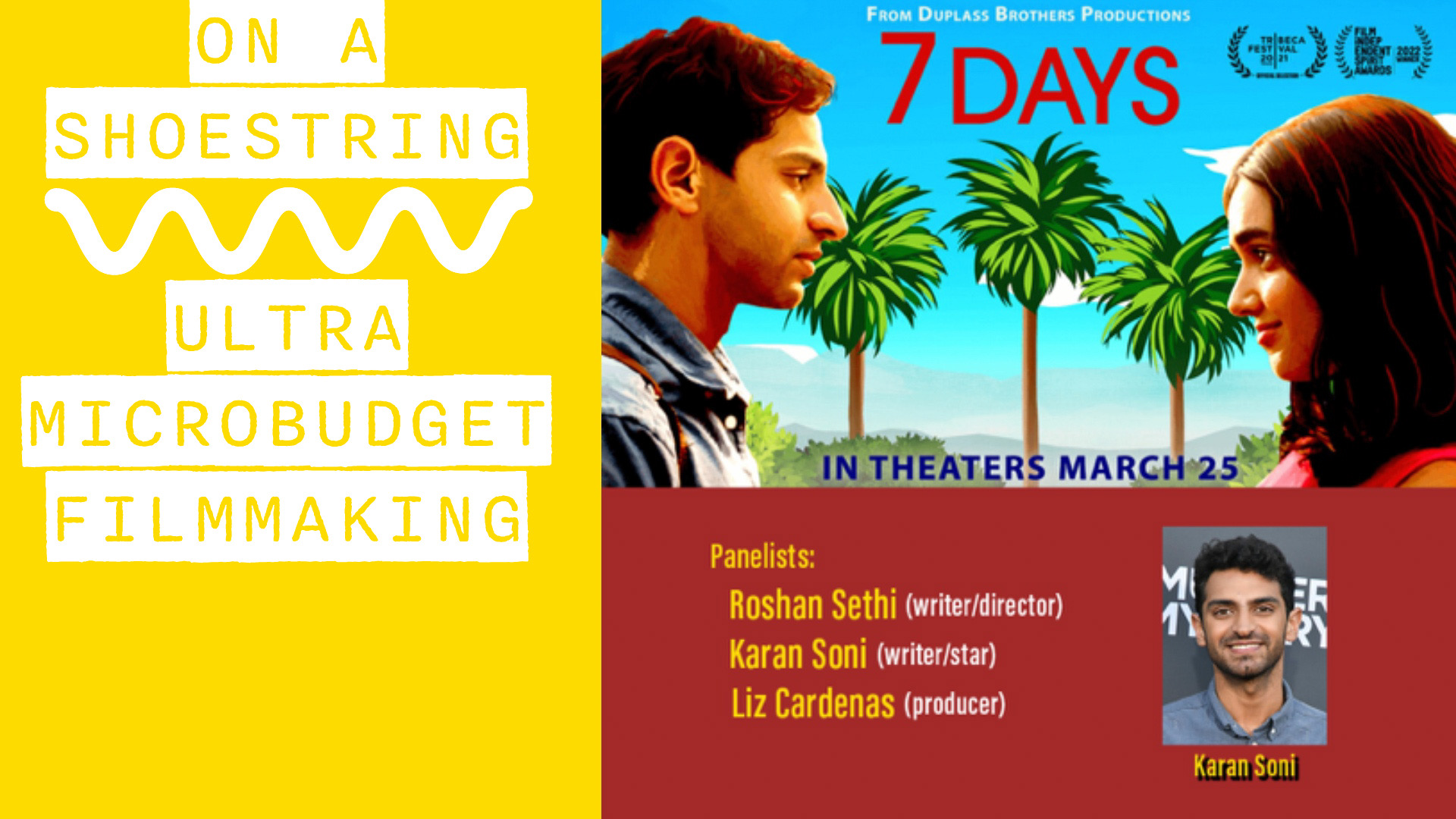On March 18, HieronyVision and Film Independent hosted a virtual panel discussion with the creative team behind the award-winning independent film 7 Days. Director/co-writer Roshan Sethi (A Nice Indian Boy, World’s Best), actor/co-writer Karan Soni (Deadpool, Miracle Workers), and producer Liz Cardenas (A Ghost Story, Never Goin’ Back) shared insights from their experience making a film for less than $100,000… and also during the height of the COVID-19 pandemic! Filmmaker and HV founder Felix Werner moderated the discussion, which turned into an honest assessment of both the advantages and obstacles to filmmaking at the ultra microbudget level.
Extreme Conditions, Extreme Budgets
So how do you make a film for less than $100K? Even though Sethi had co-created a network TV drama and Soni had starred in blockbuster films, neither had made a feature film on their own from start to finish, let alone on such a small scale. Somewhat counterintuitively, the pandemic provided an opportunity for them. Their respective shows had halted production, giving them both time and some financial cushion from the paychecks for those projects. Sethi, whose “day job” is as a doctor, had also witnessed the COVID-19 wards firsthand though his residency. Drawing on the anxiety of the time, they wrote a script in which the pandemic plays a major plot point. They also wrote it as something that could shoot easily under extreme conditions: two main characters in one main location, with a few exteriors and other characters appearing on video calls.
The Duplass Connection
Realizing their own limitations as first-time filmmakers, Sethi and Soni reached out to some people who had experience in microbudget cinema: the Duplass brothers. The mumblecore godfathers saw the potential in their project and connected them with Cardenas, a producer they knew through a mentorship program with Film Independent. A seasoned professional with respect for creative visions, Cardenas brought the balance of pragmatism, wisdom, and instinct to help Sethi and Soni make their film on a miniscule budget in a historic global health crisis.
Nostalgia for a Pandemic
7 Days was among the first productions to shoot during the summer of 2020 at the height of the pandemic. The extraordinary circumstances understandably created challenges for the creative team, though also brought unexpected advantages to a microbudget project. While the need for continuous testing created a monetary burden on the production, the safety precautions also forced the filmmakers to rely on a small, efficient crew. They also lucked out in being one of the few projects in production at that time, giving them access to experienced below-the-line talent who were willing to work at scale for a project they believed in. They also utilized other crew members, such as the production designers, to work when the primary production team was not on set. Another stroke of good fortune? Sethi was able to act as the on-set medical professional required by the pandemic protocols.
Embrace the Limitations
Eventually, the creative team turned these crazy circumstances to the project’s advantage. The biggest obstacle to the production? Finding a location they could use. However, this turned into one of the more inspired choices of the film. Cardenas scoured rental listings—which were reduced in those days—before finding a Palm Springs ranch house owned by an equine obsessive. The horse collection and décor of the main location resulted directly from this choice, as the filmmakers wrote these quirky details into the script (and were able to save on set design). The crew members were also able to stay in the area for well below market value due to the decline in demand from shelter-in-place guidelines. While there were downsides to shooting in Palm Springs during the summer (120 degree temperatures), these hurdles, along with the built in budgetary restrictions, forced the team to be incredibly efficient in an 8-day shoot with an 11-person crew on set most day.
But Would You Do It Again?
Of course, the big question is whether it’s worth it to make a project at this level at all. At the end of the day, the Sethi, Soni, and Cardenas made an award-winning film that received incredible acclaim that currently streams on multiple major platforms. Sethi and Soni were also able to tell a story that was meaningful to them, reflecting their own romantic experiences, as well as the relationships of their parents and family members, and exploring the Indian cultural mores around matchmaking and arranged marriage in the diaspora. While Cardenas has followed up with projects on a similar scale, both Sethi and Soni have moved on to larger budgets—their next collaboration, A Nice Indian Boy, is now playing in theaters and earning them more accolades and acclaim. For Soni, he sees the value in smaller projects more as an actor, mostly due to the stress of managing a production. Seth expressed more openness to returning to the microbudget level, acknowledging the creative freedom on a project like 7 Days; he also criticized Hollywood decisionmakers for their unwillingness to take risks on smaller projects, noting the lack of meritocratic standards in the industry.
So… yes-ish!
The full video of the panel discussion is available to watch on HV!



SAY HELLO!